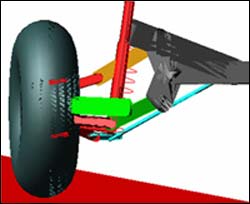
The U.S. Department of Energy’s National Renewable Energy Laboratory (NREL) has demonstrated that ventilated automotive seats not only can improve passenger comfort but also a vehicle’s fuel economy. That’s because ventilated seats keep drivers and passengers cooler, so they need less air conditioning to be comfortable.
NREL’s Vehicle Ancillary Loads Reduction team has been working with industry to try to reduce fuel consumption from air conditioning in cars and

Every year in the European Union there are over 9,000 deaths and 200,000 injured victims in road accidents in which pedestrians and cyclists collide with a car. Hoping to improve on these grim statistics, is a cutting-edge sensing system that could ultimately help to save the lives of vulnerable road users (VRUs).
“The concept is relatively straightforward,” explains Dr Marc-Michael Meinecke of Volkswagen, one of the chief partners in the SAVE-U project along with DaimlerChrysle

Researchers at the National Institute of Standards and Technology (NIST) are assisting the Department of Transportation (DOT) by developing tests for a crash avoidance system that could substantially reduce the number of rear-end, road departure and lane change accidents. About 1,836,000 such accidents occur annually, or 48 percent of police-reported cases a year.
DOT’s “Integrated Vehicle-Based Safety System” (IVBSS) for light vehicles and trucks is a single crash avoidance system u

Modeling and simulation of magnetorheological damper behavior under triangular excitation
Magnetorheological (MR) fluids are smart materials whose flow/viscosity properties can be modified by applying an electric field. These changes in viscosity occur within a fraction of a millisecond – far faster than conventional mechanical means – and can be used to effectively control vibrations in applications dealing with actuation, damping, robotics and mechatronics.
In this stu

Mechanical engineers at Purdue University have demonstrated a new method for analyzing the components of automotive suspension systems in work aimed at improving the performance, reducing the weight and increasing the durability of suspensions.
The researchers have demonstrated that their method can be used to show precisely how a part’s performance is changed by damage and also how its changing performance affects other parts in the suspension.
Findings are de

Editorial: Sports utility vehicles and older pedestrians BMJ Volume 331, pp 787-8
Sports utility vehicles (SUVs) should carry health warnings to raise awareness of the increased risk to pedestrians compared with ordinary cars, argue researchers in this week’s BMJ.
They believe that this should form part of an integrated approach from public health, transportation and road safety agencies to address this growing threat.
Among road users, pedestrians are a

To calculate microbes in milk or in the operating-room, it is necessary to make them glow like well-known glow-beetles (Lampyridae gen.) do. Now that the secret of glow-beetles’ luminescence has been discovered, and researchers of the Lomonosov Moscow State University not only synthesize the enzyme required for luminescence, but they also produce snap analysis sets based on it, the sets allowing to literally calculate microbes practically in any analysis object within several minutes. The most

An ambitious EU project created new pollution sensors for the automotive industry that could enable a multibillion euro market in emission control systems by 2010. The sensors will also help Europe to meet its CO2 obligations under the Kyoto Protocol.
The IMITEC project developed an emission control system for light duty diesel vehicles. Diesel powered vehicles are increasingly becoming a major part of the European market and already occupy more than 50 per cent of the car fleet i

Researchers from The Children’s Hospital of Philadelphia say restraints, other passengers in rear seat reduce risk
Researchers at The Children’s Hospital of Philadelphia will present today a series of findings aimed at enhancing protection for children in side-impact car crashes at the Scientific Conference of the Association for the Advancement of Automotive Medicine (AAAM). The findings demonstrate that children fare better in side-impact crashes if they are restraine

Improving survivability and mobility
A concept vehicle designed to illustrate potential technology options for improving survivability and mobility in future military combat vehicles will be shown publicly for the first time Sept. 13-15 at a military technology meeting in Virginia.
The event, “Modern Day Marine Expo,” will be held at the Marine Corps Air Facility in Quantico, Va.
The concept vehicle, known as the ULTRA AP (Armored Patrol), was built to help

As of October 1 this year the EU requires that emissions of nitrogen oxides be reduced by 30 percent in trucks and 50 percent in diesel-powered cars. In 2008 these regulations will be become more stringent in Europe, and even more so in the US. The technical solution chosen by nearly all automakers to meet the requirements was originally developed by the Lund University in Sweden. Now these researchers are working on methods to reduce nitrogen oxide emissions even more.
Emissions of nitrog

A recently completed EU project developed better tools for integrated microcircuit design; achieved some world firsts in performance analysis and now may even spin off a new company to commercialise some of its new technologies.
The DEMAND project wanted to develop a reliable and cost-effective design process for ‘smart power’ integrated circuits. This type of microchip can integrate a wide variety of functions into one piece of silicon. The advantage is lower-cost and increased r

Anticollision systems will be the next step on the way to even safer cars. Researchers in Trondheim are helping the automotive industry to turn plans into reality.
Modern vehicles contain a large number of built-in computers. The project aims to develop software for use both in anticollision systems and in systems designed to prevent car from turning over. In both systems the vehicle itself takes command when it is physically impossible for the driver himself to react sufficiently

Emerging wireless technologies for vehicle-to-vehicle communication promise to dramatically reduce fatal roadway accidents by providing early warnings to motorists. As well as improving road safety, such technologies will also help optimise traffic flow and enable drivers to take greater control of their vehicles.
This is the broad vision behind the IST-funded project CarTALK 2000. The project developed cooperative driver assistance systems and a self-organising ad-hoc radio network

A public-private effort to develop more fuel-efficient automobiles and eventually introduce hydrogen as a transportation fuel is well-planned and identifies all major hurdles the program will face, says a new report from the National Academies’ National Research Council. Many technical barriers must be overcome and new inventions will be needed, but the program, which was launched three years ago, has already made an excellent start, said the committee that wrote the report.

Novacel, a world leader in innovative industrial surface protection solutions, has launched Novacel 9377, the first adhesive film without solvent for the protection of car bodies during transport and storage. Through the launch of Novacel 9377, the French company is underpinning its commitment to a sustainable development policy.
Novacel 9377 features a 60µm adhesive film with a polyolefines basis, white in colour, and makes it possible to successfully protect car bodies against exte